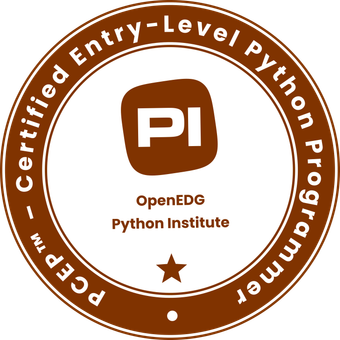PCEP

| Formats: | Asynchronous |
| Blended | |
| Online | |
| Onsite | |
| Part-time | |
| Level: | Beginner |
| Prerequisites: | |
| Recommended Knowledge | |
| Basic computer literacy | |
Formats: We offer our training content in a flexible format to suit your needs. Contact Us if you wish to know if we can accommodate your unique requirements.
Level: We are happy to customize course content to suit your skill level and learning goals. Contact us for a customized learning path.
Certified Entry-Level Python Programmer (PCEP)
Our Certified Entry-Level Python Programmer (PCEP) training course offers a comprehensive introduction to Python programming, providing students with a solid understanding of the Python language and laying the groundwork for more advanced Python training and certification. This course covers essential topics such as basic concepts, data types, evaluations, basic I/O operations, flow control, data collections, and functions. Students will learn fundamental programming concepts, master Python sequences, understand the dynamic and strongly typed nature of Python, and grasp the implications for function design. By the end of this course, participants will be well-prepared to take the PCEP certification exam and advance their Python programming skills.
Target Audience
The PCEP training course is designed for beginners with little to no programming experience who want to start their journey in Python programming. It is ideal for students, professionals transitioning into software development, and anyone interested in learning Python as their first programming language. This course is also suitable for individuals preparing for the PCEP certification exam, as it provides a thorough introduction to all necessary topics. Participants should have a basic understanding of computer operations and be eager to learn and apply new programming concepts.
Job Opportunities
Completing the PCEP training opens up a variety of entry-level job opportunities in the tech industry. Graduates can pursue roles such as Junior Python Developer, Python Programmer, QA Tester, and Automation Specialist. The foundational skills acquired in this course are highly valuable for positions that require basic programming and scripting knowledge. Additionally, the certification serves as a stepping stone for further Python certifications and advanced career opportunities in software development, data analysis, and other tech-related fields. The PCEP certification validates your proficiency in Python and enhances your employability, making you a desirable candidate for entry-level positions in the industry.
PCEP | Certified Entry-Level Python Programmer Certification
- Basic Concepts
- fundamental concepts: interpreting and the interpreter, compilation and the compiler, language elements, lexis, syntax and semantics, Python keywords, instructions, indenting
- literals: Boolean, integer, floating-point numbers, scientific notation, strings
- comments
- the print() function
- the input() function
- numeral systems (binary, octal, decimal, hexadecimal)
- numeric operators: ** * / % // + –
- string operators: * +
- assignments and shortcut operators
- Data Types, Evaluations, and Basic I/O Operations
- operators: unary and binary, priorities and binding
- bitwise operators: ~ & ^ | << >>
- Boolean operators: not and or
- Boolean expressions
- relational operators ( == != > >= < <= ), building complex Boolean expressions
- accuracy of floating-point numbers
- basic input and output operations using the input(), print(), int(), float(), str(), len() functions
- formatting print() output with end= and sep= arguments
- type casting
- basic calculations
- simple strings: constructing, assigning, indexing, slicing comparing, immutability
- Flow Control – loops and conditional blocks (20%)
- conditional statements: if, if-else, if-elif, if-elif-else
- multiple conditional statements
- the pass instruction
- building loops: while, for, range(), in
- iterating through sequences
- expanding loops: while-else, for-else
- nesting loops and conditional statements
- controlling loop execution: break, continue
- Data Collections – Lists, Tuples, and Dictionaries
- simple lists: constructing vectors, indexing and slicing, the len() function
- lists in detail: indexing, slicing, basic methods (append(), insert(), index()) and functions (len(), sorted(), etc.), del instruction, iterating lists with the for loop, initializing, in and not in operators, list comprehension, copying and cloning
- lists in lists: matrices and cubes
- tuples: indexing, slicing, building, immutability
- tuples vs. lists: similarities and differences, lists inside tuples and tuples inside lists
- dictionaries: building, indexing, adding and removing keys, iterating through dictionaries as well as their keys and values, checking key existence, keys(), items() and values() methods
- strings in detail: ASCII, UNICODE, UTF-8, immutability, escaping using the \ character, quotes and apostrophes inside strings, multiline strings, copying vs. cloning, advanced slicing, string vs. string, string vs. non-string, basic string methods (upper(), lower(), isxxx(), capitalize(), split(), join(), etc.) and functions (len(), chr(), ord()), escape characters
- Functions
- defining and invoking your own functions and generators
- return and yield keywords, returning results,
- the None keyword,
- recursion
- parameters vs. arguments,
- positional keyword and mixed argument passing,
- default parameter values
- converting generator objects into lists using the list() function
- name scopes, name hiding (shadowing), the global keyword